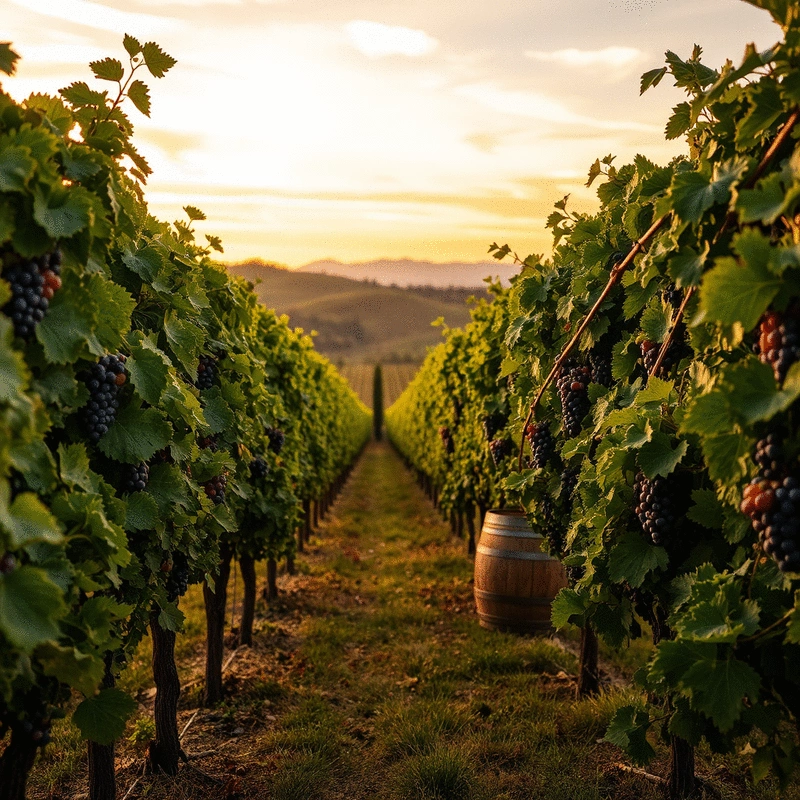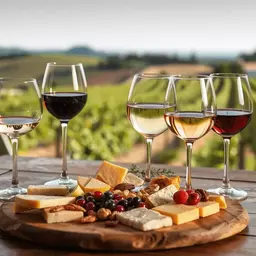Napa Valley's Winemaking Journey

Every great wine has a story, much like the rich tapestry of Napa Valley’s winemaking history. As we explore this celebrated region, we uncover tales of resilience, innovation, and tradition that continue to shape the world of wine today. Are you ready to dive into the origins of Napa Valley wine and discover what makes it so special?
What You Will Learn
- The historical significance of early vineyards established by immigrants in the mid-1800s.
- The impact of notable pioneers, including George C. Yount and Agoston Haraszthy, in shaping Napa's wine culture.
- Key grape varieties, such as Zinfandel, Cabernet Sauvignon, and Chardonnay, that define Napa Valley’s wine identity.
- The establishment of Napa Valley's first commercial wineries, including Charles Krug and Schramsberg, and their lasting influence on winemaking.
- The role of Opus One Winery in elevating Napa’s status in the global wine scene through collaboration and quality.
- The resilience of Napa Valley's winemakers through challenges like Phylloxera and Prohibition, and their ability to adapt and thrive.
- Engaging ways to explore Napa Valley today, including vineyard tours, wine festivals, and tastings that deepen your appreciation of the region.
Napa Valley Wine History Milestones
Explore the significant milestones that highlight Napa Valley's transformation into a global wine powerhouse, a journey you can learn more about by checking out this Napa Valley Wine Tasting Guide.
1836
George C. Yount establishes the first vineyard in Napa Valley, laying the foundation for the wine industry.
1861
Charles Krug opens the first commercial winery in Napa Valley, setting standards for quality winemaking.
1976
The Judgment of Paris elevates Napa Valley’s reputation in the global wine scene.
1979
Opus One Winery opens, symbolizing luxury and quality in Napa Valley wines.
Understanding the Origins of Napa Valley Wine
Every glass of Napa Valley wine tells a story, a narrative rich in history, culture, and tradition. As a wine enthusiast, I find it fascinating to dive into the roots of this incredible region. From the pioneers who first planted vines to the iconic grape varieties that define Napa Valley today, understanding these origins enhances our appreciation for each sip. Let’s embark on this journey together!
Historical Context of Early Vineyards in Napa Valley
The history of Napa Valley’s vineyards stretches back to the mid-1800s, a time when adventurous spirits sought out new beginnings. The first vineyards were planted by immigrants, particularly the Italian and German communities, who brought their winemaking traditions to the fertile soil of Napa. These early settlers faced challenges but were determined to cultivate the land, laying the groundwork for what would become one of the world’s premier wine regions.
Among the notable pioneers was George C. Yount, who is often credited with establishing the first commercial vineyard in Napa Valley. His efforts and those of others created a burgeoning industry that would eventually flourish. Isn’t it inspiring how a few courageous individuals can change the trajectory of a region? For more on exploring the region, consider these Vineyard Tours to Explore in Napa.
Pioneers and Their Impact on Napa’s Wine Industry
The impact of these early pioneers cannot be overstated. They not only planted vineyards but also shared their knowledge of viticulture and winemaking. This exchange of ideas helped to shape the unique wine culture we see today. As they cultivated the land, they also cultivated a community, bonding over their love for wine and hearty grape varieties.
- George C. Yount: Established the first vineyard in 1836.
- Agoston Haraszthy: Often referred to as the "Father of California Viticulture," he introduced many European grape varieties.
- Other immigrants: Brought diverse winemaking techniques that enriched Napa’s wine landscape.
Key Early Grapes and Their Significance
As these pioneers cultivated their vineyards, they quickly learned which grapes thrived in Napa’s climate. The early varieties planted included Mission grapes from Spain, as well as Zinfandel and Cabernet Sauvignon. These grapes played a crucial role in establishing Napa Valley’s reputation as a wine-producing region.
Have you ever tasted a Zinfandel from one of these historic vineyards? It’s a lovely reminder of the past, connecting us to those early days of winemaking!
Notable Grape Varieties: Cabernet Sauvignon and Chardonnay
Two of the most celebrated grape varieties from Napa Valley are undoubtedly Cabernet Sauvignon and Chardonnay. Cabernet Sauvignon, often considered the hallmark of Napa wines, offers bold flavors and incredible aging potential. Chardonnay, on the other hand, showcases a delightful range of styles, from crisp and mineral to rich and buttery.
- Cabernet Sauvignon: Known for its full body and rich flavors, it’s often blended with Merlot and Cabernet Franc.
- Chardonnay: A versatile grape that adapts well to different winemaking techniques, producing everything from sparkling wines to oaked varieties.
These grapes have shaped Napa Valley’s identity, making it a beloved destination for wine lovers. Each bottle captures the essence of the land and the passion of its winemakers! You can explore more about Napa Valley's Notable Winemakers Today who continue this tradition.
The Development of Napa’s First Commercial Wineries
As the vineyards flourished, the next logical step was the establishment of commercial wineries. This transformation marked a new era for Napa Valley, allowing winemakers to share their creations with the world. Exciting times were ahead as they began to refine their craft and explore innovative techniques.
Charles Krug: The Foundation of Napa Valley Winemaking
In 1861, Charles Krug opened the first commercial winery in Napa Valley, setting the standard for quality winemaking. His focus on creating premium wines laid the foundation for generations of vintners to follow. Today, the legacy of Krug continues to inspire winemakers, reminding us of the importance of tradition and innovation in the wine industry.
Other Historic Wineries: Schramsberg, Beringer, and Inglenook
Alongside Charles Krug, several other historic wineries played pivotal roles in shaping Napa Valley’s wine scene. Schramsberg, founded in 1862, pioneered sparkling wine production in California. Beringer, established in 1876, holds the title of the oldest continuously operating winery in Napa. Inglenook, which dates back to the late 1800s, is famous for its exquisite Cabernet Sauvignon.
- Schramsberg: A leader in sparkling wines, known for using traditional methods.
- Beringer: Offers a rich history and a diverse portfolio of wines.
- Inglenook: Renowned for its luxurious, high-quality wines.
These wineries helped to elevate Napa Valley’s reputation, attracting wine enthusiasts from all over!
Opus One Winery and Its Influence
In 1979, Opus One Winery opened its doors, representing a collaboration between famed winemaker Robert Mondavi and French producer Baron Philippe de Rothschild. This partnership not only combined the best of both worlds but also signified Napa Valley’s emergence on the global stage. Their commitment to quality and innovation has made Opus One a symbol of luxury and excellence.
The creation of this winery signaled a new chapter for Napa Valley, where artistry and craftsmanship flourished hand in hand. Every bottle of Opus One encapsulates the spirit of collaboration and the magic of Napa Valley! For those looking to enjoy these exquisite wines, understanding Wine Tasting Etiquette for Visitors can enhance the experience.
Quick Summary
Here's a brief recap of the key points discussed so far:
- The history of Napa Valley wine began in the mid-1800s with pioneers who planted the first vineyards.
- Key grape varieties such as Zinfandel and Cabernet Sauvignon played a significant role in establishing Napa's reputation.
- Iconic wineries like Charles Krug and Opus One have shaped the region’s legacy, combining tradition and innovation.
Frequently Asked Questions About Napa Valley Wine History
Q1: Who established the first vineyard in Napa Valley?
A1: George C. Yount is credited with establishing the first vineyard in Napa Valley in 1836, laying the groundwork for the region's wine industry.
Q2: What was the significance of Charles Krug's winery?
A2: Charles Krug opened the first commercial winery in Napa Valley in 1861, setting early standards for quality winemaking and influencing future generations of vintners.
Q3: Which grape varieties are most significant to Napa Valley's identity?
A3: Cabernet Sauvignon and Chardonnay are two of the most celebrated grape varieties, playing crucial roles in defining Napa Valley's reputation for high-quality wines.
Q4: How did Opus One Winery impact Napa Valley's global standing?
A4: Opus One Winery, a collaboration between Robert Mondavi and Baron Philippe de Rothschild, opened in 1979 and symbolized Napa Valley's emergence as a global leader in luxury and quality wines.
Q5: What challenges did Napa Valley winemakers face historically?
A5: Winemakers in Napa Valley demonstrated resilience through challenges such as the Phylloxera infestation and Prohibition, adapting and thriving despite adversity.
Summarizing Napa Valley’s Winemaking Legacy
Napa Valley’s winemaking history is nothing short of remarkable. From its humble beginnings to becoming a global wine powerhouse, the journey has been shaped by passionate winemakers, natural beauty, and a commitment to quality. By exploring these key moments, we can appreciate how Napa’s vineyards have grown and evolved, creating a legacy that influences wine lovers everywhere.
Through the years, Napa Valley has seen notable milestones that highlight its transformation. Understanding these events can help us grasp not only the rich tapestry of flavors in the wines but also the stories behind them. So, what are the key takeaways from this incredible history?
- The impact of pioneers in establishing the region’s reputation.
- The resilience shown during challenges like the Phylloxera infestation and Prohibition.
- The significance of landmark events, such as the 1976 Judgment of Paris, in reshaping Napa's image.
Engaging with Napa Valley's Wine Today and Tomorrow
As we celebrate Napa Valley’s rich winemaking heritage, there are many ways to engage with this vibrant culture. Each vineyard has its own story, waiting to be shared with visitors like you. Have you ever thought about how you can immerse yourself in the world of Napa wines? From tours to festivals, there are so many opportunities to connect with the land and its people!
Here are some exciting ways to experience Napa Valley’s winemaking legacy:
- Join a guided vineyard tour to learn about the winemaking process directly from experts.
- Attend local wine festivals, where you can sample a variety of wines and meet passionate winemakers.
- Participate in wine tastings that explore different grape varieties and their unique flavors.
Encouraging Future Exploration and Appreciation of Napa Wines
As we look forward, it’s essential to encourage exploration and appreciation of Napa wines. The more we engage with the vineyards and the stories they hold, the deeper our understanding becomes. One of my favorite aspects of visiting Napa Valley is the chance to savor not just the wines but the experiences that come with them. Are you ready to discover the hidden gems of this beautiful wine country? Consider these Napa Valley Vineyard Tour Itineraries for your next adventure.
At Vineyard Vistas Blog, I’m dedicated to guiding you through each sip and story, making your journey through Napa Valley unforgettable. So, let’s raise a glass and celebrate the past, present, and future of Napa Valley’s winemaking legacy together!
Recap of Key Points
Here is a quick recap of the important points discussed in the article:
- Napa Valley's winemaking history began in the mid-1800s with immigrants, particularly from Italy and Germany, who laid the foundation for the region's vineyards.
- Pioneers like George C. Yount and Agoston Haraszthy played crucial roles in introducing grape varieties and shaping Napa's unique wine culture.
- Key grape varieties such as Zinfandel, Cabernet Sauvignon, and Chardonnay have become synonymous with Napa Valley's identity.
- The establishment of commercial wineries, starting with Charles Krug in 1861, marked a significant milestone in Napa Valley's winemaking journey.
- Historic wineries like Schramsberg and Beringer contributed to elevating Napa's reputation as a premier wine destination.
- The collaboration of Opus One Winery in 1979 highlighted Napa Valley's emergence on the global stage, symbolizing luxury and quality.
- Engaging with Napa Valley today offers opportunities through vineyard tours, wine festivals, and tastings, enhancing appreciation of the region's legacy.



